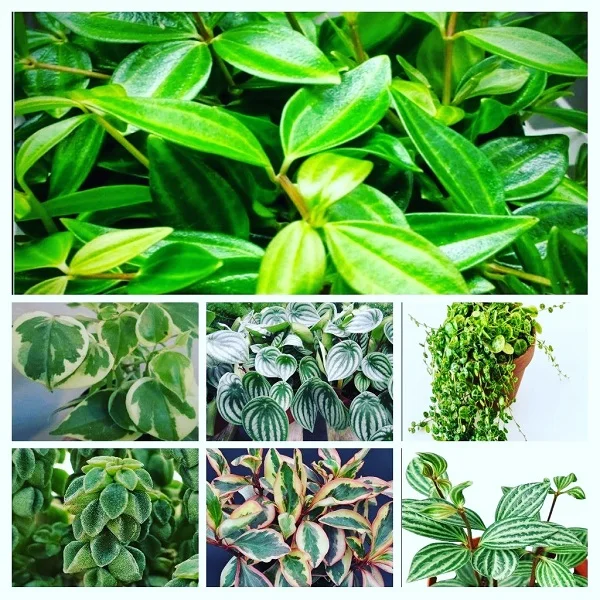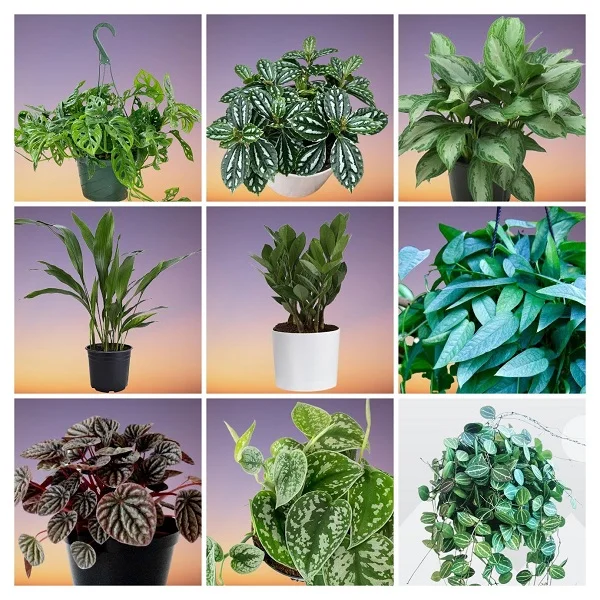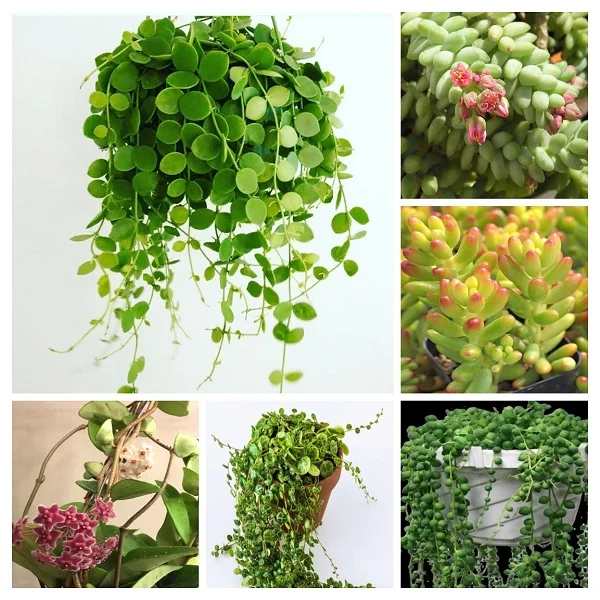How to Grow and Care for Peperomia puteolata (Parallel Peperomia) Indoors
Some links in this post may be affiliate links
Peperomia puteolata (Parallel Peperomia) flourishes in medium to bright light, warm and humid conditions and moderately moist, rich, well-drained soil coupled with monthly feeding in the growing season.
Whether displayed in hanging baskets, pots, or terrariums, Parallel Peperomia thrives indoors with minimal effort. This guide covers everything you need to know about growing and maintaining Peperomia puteolata indoors, from light and watering needs to soil, propagation, and common issues.
Parallel Peperomia is among the popular trailing Peperomia varieties and produces cascading stems and oval-shaped leaves with attractive patterns similar to the stripes found on watermelon rinds.
The leaves are patterned in dark green and white and grow in whorls around the plant stems. The stems are a deep maroon or reddish color. These characteristics make Parallel Peperomia one of the best plants for an office space where they can be a great conversation starter.
The compact size and beautiful foliage of Peperomia tetragona make it perfect for a hanging basket, a pedestal, a tabletop, desktop or any limited space.
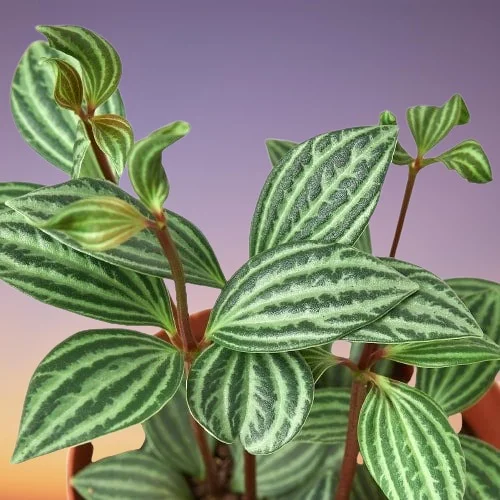
Botanical name: Peperomia puteolata
Synonym: Peperomia tetragona
Family: Piperaceae
Common name Parallel Peperomia
Origin
Peperomia puteolata also called Peperomia tetragona is native to South America where it is found growing on forest floors with a fast spreading nature.
Is Parallel Peperomia toxic?
No. Peperomia puteolata like other Peperomia is non-toxic to humans and pets. Parallel Peperomia is safe for cats, dogs and other pets.
Where to Buy
If you are looking to acquire Peperomia for your collection, they are available online on Amazon (Link to Amazon).
How to care for Peperomia puteolata indoors
To care for Peperomia puteolata indoors, provide medium to bright indirect light (filtered light), average warmth of 15-260C, humidity of 55-65% and moderately moist, fertile, well-drained, all purpose soil coupled with monthly feeding in spring and summer
Peperomia tetragona care requires regular pruning to keep it neat, minimize pest and disease infestations as well as rejuvenate growth. Repotting is only needed when the plant becomes extremely pot-bound. Keep reading for more details on these growing conditions and how to achieve them.
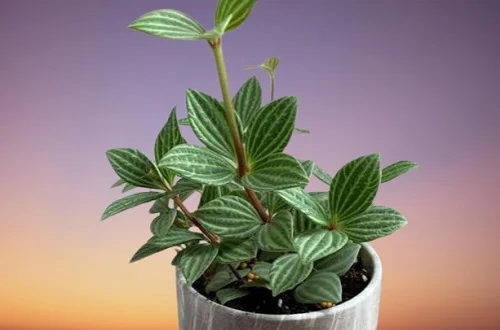
Watering
How often should I water Parallel Peperomia?
Water your Parallel Peperomia liberally in spring and summer and allow the top 2-3 inches of soil to dry out between waterings. Maintain the soil moderately moist and avoid watering to prevent rotting, yellowing, wilting and leaf drop.
Cut down on watering in fall and winter to keep the soil barely moist as growth is minimal at this time. Do not allow the soil to dry out completely as it can result in wilting and drooping leaves.
Use water that is at room temperature to avoid shocking the plant to prevent stunted growth and leaf drop. Ascertain that the water is free of chlorine and other chemicals as they can lead to brown leaf tips and edges.
Ensure that the pot has a drainage hole and the soil is well-draining to prevent waterlogging as it can result in root-rot disease and death of the plant.
Take care not to wet the foliage to minimize fungal diseases; you may water from the bottom instead.
Light Requirements
Does Parallel Peperomia like full sun?
No. Parallel Peperomia grows best in medium to bright indirect light. Put it near a brightly-lit window but away from direct sunshine to prevent scorching of the leaves.
Too little light will result in a leggy plant and loss of leaf color. Therefore, where the natural light is not adequate, use a grow light to supplement it.
Regularly rotate the pot to ensure that the plant receives light on all sides for a balanced growth as well as prevent a leggy growth.
Temperature & Humidity
Peperomia puteolata prefers an average warmth of 15-260C. Keep it away from sources of drafts like AC units, hot air vents, stoves, windy doors, drafty windows and others as they can cause reduced growth and leaf drop.
Parallel Peperomia thrives in a humidity of 55-65%. Too low humidity can lead to brown leaf tips and edges. To increase humidity, set the pot on a wet pebble tray, use a cool mist humidifier or grow the plant in a closed terrarium where a high humidity can be maintained.
Do not mist or wet the leaves as it can encourage fungal diseases. Ensure that there is good air circulation to depress fungal infestations.
Fertilizer
What is the best fertilizer for Parallel Peperomia?
Feed your Parallel Peperomia with a balanced, liquid fertilizer every 4 weeks during the growing period (spring and summer) to promote a lush growth.
Withhold feeding in fall and winter as growth is minimal and feeding at this time may lead to fertilizer burn. Avoid over-fertilizing, as it can cause burnt leaf tips.
Occassionally flush out accumulated salts from the soil by running a stream of water through the soil until it comes out through the drainage holes. Repeat the process several times to remove as much as possible of the accumulated salts.
Potting Soil
What kind of soil does Parallel Peperomia like?
Parallel Peperomia likes a rich, aerated, well-draining soil mix to prevent it from getting soggy while providing the required nutrients.
Repotting
Repot your Parallel Peperomia in the beginning of the growing season (spring to early summer), only when the plant has become pot-bound.
Select a pot one size larger than the current one to avoid over potting. Make sure that the pot has a drainage hole and the soil is well-draining to avoid getting soggy soil which can lead to root-rot and plant death. Take a look at these ceramic pots with drainage holes on Amazon.
Pruning & Grooming
Pruning Parallel Peperomia involves regular removal of dead foliage to maintain the plant tidy as well as to minimize pests and disease infestations.
To encourage a bushy, compact growth of the plant, regularly pinch off the growing tips by snipping at a point just above a leaf node.
As it ages, Peperomia puteolata becomes straggly therefore, cutback the stems with a sharp, clean pair of pruning scissors during the growing season to rejuvenate growth.
Clean the leaves regularly by damp-wiping with a soft cloth to get rid of dust and also discourage pest and disease infestations.
Propagation: How to multiply Peperomia puteolata
Peperomia puteolata (Parallel Peperomia) is easily propagated from leaf cuttings, stem cuttings or by plant division in spring to early summer when in active growth.
Learn more on how to propagate Parallel Peperomia (Peperomia puteolata) by 5 methods.

Peperomia puteolata Problems & Remedies
Parallel Peperomia (Peperomia puteolata) problems are yellow leaves, dropping leaves, drooping leaves, brown leaf tips, pests and diseases among others. Keep reading for more on these problems and how to fix them.
Yellow leaves
The main causes of yellow leaves on Peperomia puteolata are inconsistent watering, soggy soil, nutrients deficiency or too little light.
How to fix it
Inconsistent watering: Water when the top 2-3 inches of soil dry out but never allow the soilball to dry out completely. Do not water on a schedule.
Soggy soil: Use a pot with a drainage hole and well-draining soil.
Nutrients deficiency: Feed the plant with a balanced, water-soluble fertilizer every 4 weeks in spring and summer.
Too little light: Place the plant in a brighter spot where it will receive medium to bright indirect light or use a grow light is the natural light is not adequate.
Dropping leaves
Some of the causes of dropping leaves on Parallel Peperomia are incorrect watering, soggy soil, and insufficient light.
How to fix it
Incorrect watering: Water when the top 2-3 inches of soil dry out but never allow the soil to dry out completely. Do not water on a schedule.
Soggy soil: Pot the plant in a pot with a drainage hole and well-draining soil.
Insufficient light: Place the plant in medium to bright indirect light or use a grow light if the natural light is not enough.
Drooping leaves
The main causes of drooping leaves on Peperomia puteolata are direct sunlight, inconsistent watering, soggy soil, temperature stress, spider mites, and salts buildup.
How to fix it
Inconsistent watering: Water when the top 2-3 inches of soil feel dry out but do not allow the soil to dry out completely.
Soggy soil: Use a pot with a drainage hole and well-draining succulents soil.
Temperature stress: Keep the plant away from drafts emanating from AC units, heat sources, windy doors and windows among others.
Spider mites infestations: Regularly inspect the plant for these pests and carry out timely control measures.
Salts buildup: Occasionally flush out the salts from the soil by running a stream of water through the soil until it comes out through the drainage holes.
Brown leaf tips and edges
Brown leaf tips and edges on Parallel Peperomia are due to cold drafts, dry air and salts buildup.
How to fix it
Remove all the damaged leaves to keep the plant neat and tidy.
Cold drafts: Keep the plant away from cold drafts emanating from windy doors, drafty windows, AC units among others.
Dry air: Set the pot on wet pebble tray or use a humidifier to raise humidity. You may grow the plant in a well-lit bathroom and other humid places in the home.
Salts buildup: Flush out the salts from the soil every 1-2 months by running a stream of water through the soil until it comes out through the drainage holes.
Pests
Common pests on Parallel Peperomia are scale insects, whiteflies, mealybugs and spider mites.
How to fix it
- Isolate the affected plant to prevent spread to other plants.
- Treat the infested plant with insecticidal soap as per the manufacturer's recommendations.
- Regularly, check between and underneath the leaves for these pests and carry out timely control measures.
- Keep the plant well pruned to depress the pest infestations.
Diseases
Peperomia puteolata is prone to the following two diseases:
1. Leaf spot disease which is enhanced by damp, stuffy conditions. It presents as brown, soft leaf spots.
How to fix it
- Isolate the affected plant and treat it with horticultural oil as per the manufacturer's instructions.
- Avoid wetting the leaves during watering to minimize the disease infestation; water from the bottom instead.
- Improve the air flow for the plant to discourage the disease.
2. Root-rot disease which is prevalent in soggy soil. It is characterized by wilted and discolored leaves and corky swellings under the leaves.
How to fix it
- Gently, slip the plant out of its pot and inspect the roots; brown-black mushy roots indicate root-rot.
- Cut away the rotten roots and treat the healthy roots with a copper-based fungicidal solution as indicated by the manufacturer.
- Repot the plant in fresh soil and a fresh pot.
- Use a pot with a drainage hole and well-draining soil to prevent it from getting soggy.
- Place the plant in bright light and stop watering for a few days to give the plant enough time to loss the excess water. After the dry period, resume routine care.
Conclusion
Peperomia puteolata (Parallel Peperomia) is a low-maintenance, pet-friendly, and visually appealing houseplant that adds a touch of greenery to any indoor space. By providing proper lighting, watering, and occasional pruning, you can enjoy this unique plant for years.
Frequently Asked Questions
1. Does Parallel Peperomia need full sun?
No. Parallel Peperomia blossoms in medium to bright light away from direct sunshine as it may cause scorching of the leaves.
2. How do you care for Parallel Peperomia?
- Grow Parallel Peperomia in medium to bright indirect light (filtered light) to avoid scorching.
- Maintain an average warmth of 15-260C and keep it away from cold drafts.
- Keep it in a humid environment, above average room humidity of 55-65%.
- Give it well-drained, rich, well-drained, all purpose soil. Keep the soil moderately moist during the growing season and slightly moist in the cold season.
- Feed it monthly with a balanced, liquid fertilizer during the growing season but do not feed in the cold season.
- Regularly remove dead and dry leaves to maintain the plant neat and also discourage pest and disease infestations.
- To encourage a compact growth of the plant, regularly pinch off the growing tips.
- With time, the plant becomes straggly therefore, cutback the stems during the growing season to rejuvenate growth.
- Repot Parallel Peperomia during the growing season when it is pot-bound. Use a pot one size larger than the current one. Ensure that the pot has a drainage hole to avoid soggy soil as it can result in root-rot.
- Regularly inspect the plant for pests and diseases and carry out timely control measures.
3. What are the benefits of Peperomia puteolata?
- Peperomia puteolata is an easy-care, low maintenance, compact plant that is perfect for hanging baskets and the limited spaces.
- Its attractive foliage which appear like the rind of watermelons is a sight to behold in any space in the home.
- Peperomia puteolata is non-toxic to both humans and pets. It is safe to grow in the home.
4. Parallel Peperomia (Peperomia tetragona) propagation?
Parallel Peperomia is propagated during the growing season from leaf cuttings, stem-tip cuttings or by plant division.
5. How often should I water Peperomia puteolata?
Water Parallel Peperomia when the top 2-3 inches of soil are dry. Avoid overwatering.
6. Can Peperomia puteolata grow in low light?
Peperomia puteolata can survive in low light, but it will grow slower and become leggy.
7. Why are my Peperomia puteolata leaves turning yellow?
Yellowing leaves are usually a sign of overwatering. Ensure the soil drains well.
8. Is Peperomia puteolata toxic to pets?
No. Peperomia puteolata is non-toxic to cats and dogs.
You liked it? Share on social media.
Related Content
Amazon Associates Disclosure
Homeplantsguide.com is a participant in the Amazon Services LLC Associates Program, an affiliate advertising program designed to provide a means for sites to earn advertising fees by advertising and linking to amazon.com.



